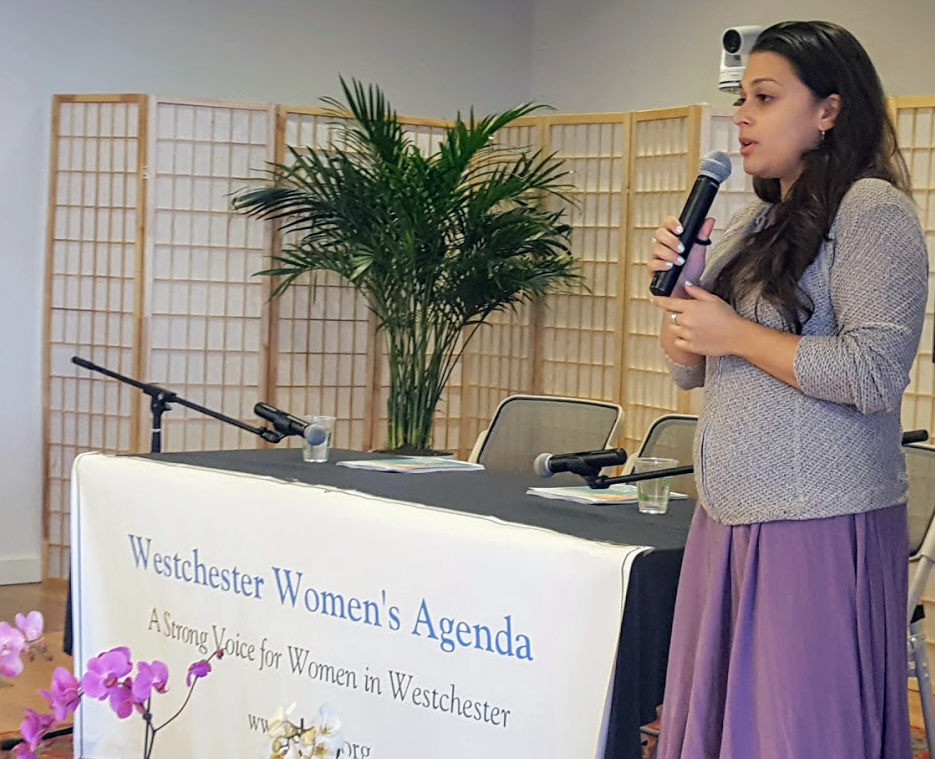
Even though the educational levels of women in Westchester now slightly exceed those of men, women across the county ”” including those who work in full-time comparable positions ””make less money than their male counterparts, according to a new report by the Westchester Women”™s Agenda.
Citing U.S. Census data, the report notes that in 2014, median earnings for women over the age of 25 were $42,895. For men, that figure was $59,433. The pay disparity is present at all levels of education, from high school graduates to those with advanced degrees, the report found.
“At the current rate of progress, it will take until 2049 for women to reach parity in pay,” said Sheila Klatzky, secretary and board member of the Westchester Women”™s Agenda.
Founded nearly 20 years ago, the Westchester Women”™s Agenda is a feminist coalition of more than 50 nonprofits, individuals and corporations that serves as a voice for women in the county on legislative policy and program issues. Klatzky said the group hosts meetings each month and advocates mostly on the county level.
The organization”™s Report on the Status of Women in Westchester was co-sponsored by Irvington-based women”™s apparel brand Eileen Fisher and was the result of a nearly six-month effort by more than a dozen volunteers.
“There is currently little information gathered about the status of women in Westchester,” said Maria Imperial, CEO of the YWCA of White Plains and Central Westchester and a member of Westchester Women”™s Agenda. “A lack of comprehensive current information about women and girls hinders efforts to advance gender equality.”
Klatzky, who joined the organization in 2010, believes the report to be the first such study undertaken by the organization.
“The idea behind this was to create a baseline and to lay the foundation for doing this on an ongoing basis, so we can track the progress of women in the county,” she said.
The report concluded that high costs of child care across the county force many potential female workers to stay home with their children. Nearly half of the respondents in a survey by the Child Care Council of Westchester indicated that they had trouble paying for child care in the last six months.
“For a woman with two kids, it hardly pays to step outside the house,” Klatzky said.
To deal with these high child care costs, nearly half borrowed money from their families and a third moved their children from regulated to informal child care. More than a quarter reduced their working hours.
“I see it as a very heavy burden and a very difficult, if not impossible, set of circumstances, especially for women of modest means,” she said, “and there are a lot of women of modest means in Westchester.”
The report also noted a declining birth rate in Westchester. Between 2005 and 2014, the birth rate fell steadily, from 12.8 per 1,000 women in 2005 to 10.9 per 1,000 in 2014.
“All these pieces fit together in a puzzle, but it”™s understandable why women would not want to have babies under the current conditions,” Klatzky said. “The choices are really very bleak and that”™s discouraging.”
Additionally, the percentage of women-owned businesses in Westchester is slightly lower than the national average. Fewer than 35 percent of firms in Westchester are owned by women, and those firms generate roughly 25 percent of the annual revenues generated by male-owned businesses.
County Legislator Catherine Parker, a Democrat who owns travel store Parker in downtown Rye, is optimistic. Parker said she has seen a robust increase in women-owned businesses over the last few years, though some challenges still remain.
“Oftentimes, funding is the most difficult obstacle, particularly for women who may have had to stay at home to raise children and taken a long hiatus from employment,” she said.
According to the report, women account for 16 percent of conventional small-business loans and receive 4.4 percent of the total dollar value for loans.
Klatzky hopes the report”™s findings will encourage county officials to look into funding additional training and workshop classes for women who aim to start their own companies.
“It”™s a powerful tool for lifting women out of poverty and there are plenty of success stories of women who have started their own businesses,” Klatzky said. “They need help, guidance and resources, and those are resources well spent.”
The report found that more than 10 percent of families in Westchester live in poverty. That figure is even higher for female-headed families across the county. About 20 percent of female-led households lived in poverty in 2014, a figure that rose from 17.9 percent in 2009.
“The report shows we are wasting a tremendous amount of human potential by not giving women the tools and opportunities they need to be successful,” Klatzky said.
Parker noted that the county has provided funding to the Women”™s Enterprise Development Center, an organization that assists in writing business plans and offers training to women. However, “I”™m sure if they were given additional monies, they could meet the needs of more women,” she said.
The report was not entirely negative news for women, Klatzky said. The study found that educational levels have improved for both men and women across the county and that New York is the only state in the nation where millennial women tend to make more money than their male counterparts. Additionally, three of the top seven Fortune 500 companies headquartered in Westchester are led by women.
“Still, a lot more needs to be done. We need to do a lot more to create opportunities for women in Westchester to thrive,” Klatzky said. “We want to use this report to start a conversation in the community about what we can do to change things.”




















